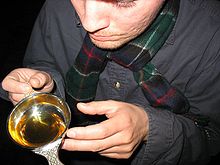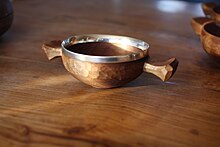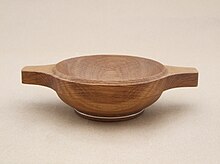| Revision as of 01:35, 28 November 2011 editRich Farmbrough (talk | contribs)Edit filter managers, Autopatrolled, Extended confirmed users, File movers, Pending changes reviewers, Rollbackers, Template editors1,725,877 editsm Fix spelling Encyclopædia Britannica or similar; using AWB← Previous edit | Revision as of 14:20, 24 July 2012 edit undoMacRusgail (talk | contribs)Autopatrolled, Extended confirmed users, Pending changes reviewers69,085 editsNo edit summaryNext edit → | ||
| Line 37: | Line 37: | ||
| ] | ] | ||
| ] | ] | ||
| ] | |||
| ] | ] | ||
Revision as of 14:20, 24 July 2012
| This article needs additional citations for verification. Please help improve this article by adding citations to reliable sources. Unsourced material may be challenged and removed. Find sources: "Quaich" – news · newspapers · books · scholar · JSTOR (March 2011) (Learn how and when to remove this message) |

A quaich (/ˈkweɪx/), archaically quaigh, is a special kind of shallow two-handled drinking cup or bowl in Scotland. It derives from the Scottish Gaelic cuach (Scottish Gaelic pronunciation: [kʰuəx]) meaning a cup.
According to the 1911 Encyclopædia Britannica, the quaich was inspired by the low silver bowls with two flat handles frequently used as bleeding vessels in England and the Netherlands in the 17th century. Another popular theory suggests that the shape is derived from scallop shells. However, this seems to have had its origins in the now discredited "Poems of Ossian".
In his 1955 monograph "Some Scottish Quaichs", Richard L. McCleneahan, an American collector, suggests alternatively that quaichs evolved directly from medieval Mazers. This seems unlikely as the form and material (burr maple for mazers) are quite different. There were small stave built drinking vessels common in the medieval period found around the Baltic and since some of the earliest quaichs are stave built this could be the source.

Traditionally quaichs are made of wood, an artform known as "treen". Some early quaichs are stave-built like barrels and some have alternating light and dark staves. The staves are held together by bands of willow or silver. They generally have two, and more rarely three or four, short, projecting handles. Other wooden quaiches were lathe-turned out of a single piece of wood and there was another group which were turned then carved outside in basket-weave pattern. In addition to wood, they are made of stone, brass, pewter, horn, and silver. The latter were often engraved with lines and bands in imitation of the staves and hoops of the wooden quaichs.

The origin of quaichs in Scotland is traced to the Highlands; it was not until the end of the 17th century that they became popular in such large centres as Edinburgh and Glasgow. The silversmiths of such local guilds as Inverness and Perth frequently mounted them in silver, as may be seen from the hallmarks on the existing examples.
Commemorative quaichs awarded as prizes, or given as gifts, are more commonly made of pewter or silver. These prize cups are rarely used for actual drinking.
Related vessels to the Scottish quaich include the porringer, a larger vessel typically 6 inches (15 cm) in diameter with one (US colonial) or two (European) horizontal handles. The Sami and Norrland, Sweden, equivalent is the kuksa, which also only has a single handle.
The quaich was used for whisky or brandy, and in the 19th century Sir Walter Scott dispensed drams in silver quaichs, but the quaich he kept for himself was particularly precious to him.
In 1745 the quaich had travelled from Edinburgh to Derby with the Scottish Army in Bonnie Prince Charlie's canteen.
Some quaichs' bottoms are made of glass, allegedly so that the drinker could keep watch on his companions. A more romantic quaich had a double glass bottom in which was kept a lock of hair so that the owner could drink from his quaich to his lady love, and, in 1589, King James VI of Scotland gave Anne of Denmark a quaich or "loving cup" as a wedding gift.
Notes
- McClenehan, Robert L. Some Scottish Quaichs. Illinois, 1955, p. 3.
See also
- Loch Quoich
- Centenary Quaich – a rugby football competition
External links
![]() This article incorporates text from a publication now in the public domain: Chisholm, Hugh, ed. (1911). Encyclopædia Britannica (11th ed.). Cambridge University Press.
This article incorporates text from a publication now in the public domain: Chisholm, Hugh, ed. (1911). Encyclopædia Britannica (11th ed.). Cambridge University Press. {{cite encyclopedia}}: Missing or empty |title= (help)